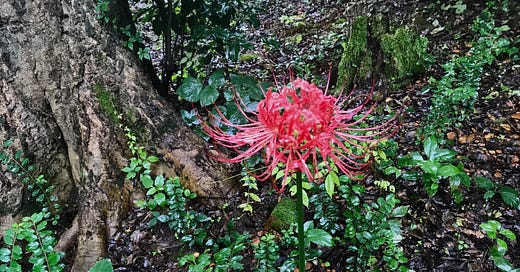Higanbana
A mysterious red flower, the uncertainty of the equinox, and the calming power of singing bowls
Vol. 1, Issue 11
Last week I noticed an odd splash of red in my backyard. At first, from my kitchen window, I thought it was a bird splayed out on a pokeweed stalk. But when I went outside to take a closer look, I was startled to find a very tall and unusual flower. It was the only one of its kind, nestled close to the trunk of an oak tree. It had seemingly sprouted up overnight.
I used the iNaturalist app to identity it: a red spider lily, also known as a hurricane lily, magic lily, or Higanbana. Native to Asia, the spider lily is an especially important flower in Japan, where it’s the sacred flower of Ohigan, a seven-day Buddhist holiday celebrated twice a year, during the spring and fall equinoxes. There, red spider lilies are planted on graves and are associated with the cycle of death and rebirth.
Right on cue, my spider lily bloomed just in time for this week’s fall equinox, and it has served as a much-needed reminder that the season is, in fact, changing. Autumn in Alabama is generally a muted time of year; most leaves don’t turn pretty colors, the weather is only moderately cooler, and there’s no real sense of “harvest” culture, unlike where I grew up in Wisconsin. (Perhaps worst of all, I haven’t yet found an apple cider donut down here.)
Yet as the long and taxing second year of the pandemic grinds toward its final, Delta-ridden months, I do sense some change in the air. I spent much of last spring and summer experiencing the death of my previous understanding of the world and the minds of other people. But now I think I’ve come to the end of my grief for that past perspective, and I’m beginning to feel the stirrings of a new understanding, a new awareness of the complicated intersection of self-reliance with social interconnectedness.
More frankly, it’s not easy to live in a place where most people around me don’t share my values or views, but the more clear-eyed I am about this reality, the better equipped I am to detach emotionally and simply endure it. This is fast becoming my personal, fundamental dharma for coping during the pandemic era.
At the equinox, day and night are as close to equal length as they’ll ever be. And this year, in the midst of my own attempt to balance the light and dark of the universe, it means a lot to me that one offbeat red flower has somehow managed to not only survive, but bloom majestically.
Listen
In honor of my hurricane lily:
Read
Folklore & Nature: The Death Flower, Kelly Brenner. “In Japan, [the red spider lily] has over 1,000 different names. Many of those names relate to the unique folklore of the flower, which is multifaceted. Many (if not most) of the names are associated with death.”
How lockdown may have changed your personality, BBC. “This time of reflection might lead to increases in ‘self-concept clarity’—the degree to which people have coherent beliefs about themselves and their goals in life.”
A Forgotten Female Flower Painter, Hyperallergic. “One hundred years after Mary Hiester Reid’s death, Flower Diary recovers the elusive, overlooked artist’s life and work.”
Consider
In a previous life (i.e. shortly after I graduated college), I joined a meditation group that met every Friday evening. While I no longer regularly meditate, I’m still occasionally drawn back to it when I need to refocus. In keeping with this week’s theme, I searched for a Japanese Buddhist-style meditation video, but I couldn’t find one that felt right for this newsletter. Instead, here is a crystal singing-bowl meditation, which blends concepts from Tibetan Buddhism, Hinduism, and American New-Ageism. I hope you find it calming.
First/Last words
All day I have watched the purple vine leaves
Fall into the water.
And now in the moonlight they still fall,
But each leaf is fringed with silver.
—Autumn, by Amy Lowell
This week is both the end of summer and the beginning of fall, and the brief liminal space between the seasons is both exciting and unsettling. In your own creative work, I suggest you try to consciously inhabit this in-between. Maybe guide your characters to the precipice of a major change. Maybe try to either juxtapose or blend two very different images or concepts. Maybe just rip a piece of paper in half and stare awhile at the space you’ve created between the two parts.
Whatever you do, be in the midst of it.
Connect
You can find Sandra on Twitter, Instagram, and at sandrabarnidge.com. As always, thank you for being here.




